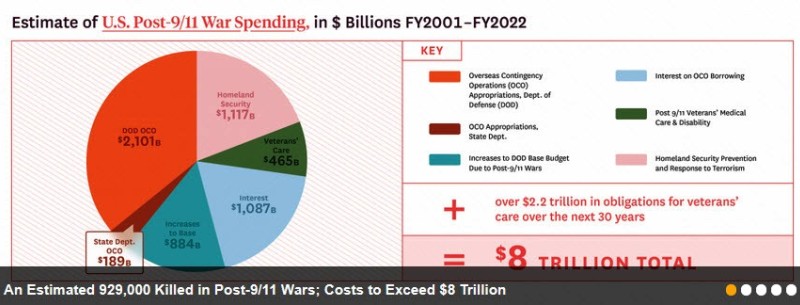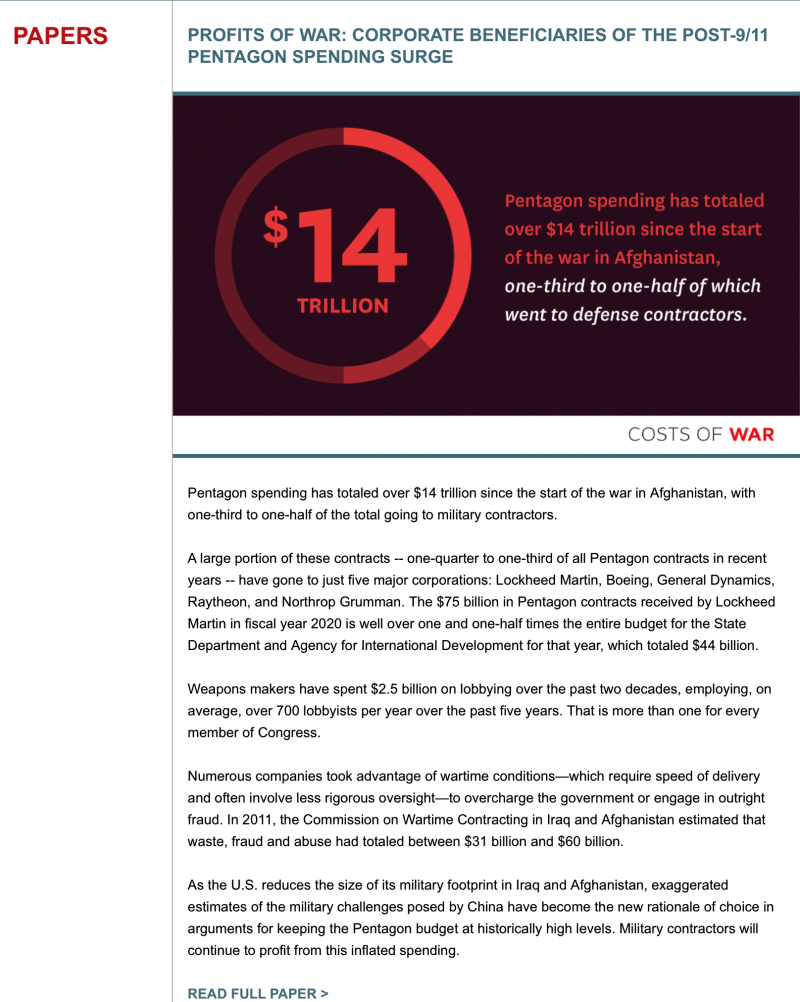File:Costs of War US Post 9-11 War Spending.jpg
Costs_of_War_US_Post_9-11_War_Spending.jpg (800 × 305 pixels, file size: 60 KB, MIME type: image/jpeg)
GreenPolicy360.com & StrategicDemands.com
"Deep Costs, Failed Policies, Time for a New Vision"
Costs of War... Continuing on and on...
"Perpetual War for Perpetual Peace"
- by Gore Vidal
In US fiscal year 2023, out of a $1.8 trillion federal discretionary budget, $1.1 trillion — or 62 percent— was for militarized programs. That includes war and weapons, law enforcement and mass incarceration, and detention and deportation. Less than $2 out of every $5 in federal discretionary spending was available to fund investment in people and communities. ... The U.S. spent $16 on the military and war for every $1 that was spent on diplomacy and humanitarian foreign aid.
-- Via Institute for Policy Studies
Cost of Two Decades of War Post 9/11
A Trail of Death, Destruction & Failed Security Policy
The Cost of the Post-9/11 Security State Is $21 Trillion
Add Up the Numbers -- $8, $14, $21 Trillion
- Then go beyond to the full costs of war, generational
Ⅰ Ⅱ Ⅲ Ⅳ Ⅴ Ⅵ Ⅶ Ⅷ Ⅸ Ⅹ Ⅺ Ⅻ — Ⅻ Ⅺ Ⅹ Ⅸ Ⅷ Ⅶ Ⅵ Ⅴ Ⅳ Ⅲ Ⅱ Ⅰ
Time for a New Vision, New Definitions of National & Global Security
- Time for New Priorities, Time for Real Security
New Definitions of National Security
Ⅰ Ⅱ Ⅲ Ⅳ Ⅴ Ⅵ Ⅶ Ⅷ Ⅸ Ⅹ Ⅺ Ⅻ — Ⅻ Ⅺ Ⅹ Ⅸ Ⅷ Ⅶ Ⅵ Ⅴ Ⅳ Ⅲ Ⅱ Ⅰ
State of Insecurity
The war in Afghanistan is coming to a close just days before the 20th anniversary of its preceding event: the 9/11 attacks. Even as the US government pledges to keep attacking targets in the country there—producing horrific collateral damage—the military is out, and we’re beginning to take stock of its enormous cost...
A new study from the National Priorities Project at the progressive Institute for Policy Studies calculates that over the 20 years since 9/11, the United States has spent $21 trillion on “militarization, surveillance, and repression...”
Analyses of data from all the US post-9/11 war-on-terror violence paint (a stark) picture: $6.4 trillion in direct spending on wars and war-related costs; 800,000 killed directly in the wars in Afghanistan, Iraq, Pakistan, Syria, Yemen, and elsewhere; 38 million displaced; and “counterterrorism” operations in 85 countries.
But that’s still not a full accounting of US foreign and domestic military and related activity in the wake of 9/11. A new study from the National Priorities Project at the progressive Institute for Policy Studies calculates that over the 20 years since 9/11, the United States has spent $21 trillion on “militarization, surveillance, and repression,” when analyzed holistically.
“Twenty years later, the War on Terror has fed a sprawling security apparatus that was designed for counterterrorism but has also taken on immigration, crime, and drugs,” the report’s authors wrote.
The policy and spending choices made in this era have “turbo-charged militarism and xenophobia” internationally and domestically, they wrote, and have “driven some of the deepest divisions in US politics, including the growing threats of white supremacy and authoritarianism.”
And although some of the ill effects are hard to measure monetarily, there are figures that can be cited, the paper argues. For the military, the cost has been $16 trillion, including $7.2 trillion for military contracts. Additionally, the authors tabulated $3 trillion for veterans’ programs, $948 billion for the Department of Homeland Security, and $731 billion for federal law enforcement.
Some may find the $21 trillion figure over-inclusive, since most of these agencies would have spent considerable sums even in the absence of the 9/11 attacks. But the authors argue that spending on federal law enforcement programs is relevant “because the militarization of police and the proliferation of mass incarceration both owe much to the activities and influences of federal law enforcement. The same agencies use the same militarized tactics to combat terrorism, crime, and narcotics.” Additionally, they argue, federal law enforcement agencies operate domestically and globally and frequently collaborate with the Department of Defense.
○
File history
Click on a date/time to view the file as it appeared at that time.
| Date/Time | Thumbnail | Dimensions | User | Comment | |
|---|---|---|---|---|---|
| current | 22:20, 1 September 2021 | 800 × 305 (60 KB) | Siterunner (talk | contribs) |
You cannot overwrite this file.
File usage
The following 2 pages use this file:
- Additional Website Resources - Linked Data - Green Best Practices
- Atmospheric Science
- Climate Change
- Climate Policy
- Earth System Science
- Ecology Studies
- Eco-nomics
- Education
- Energy
- Environmental Protection
- Environmental Security
- Environmental Security, National Security
- Envirosecurity
- Fossil Fuels
- Global Security
- Green Energy Initiatives
- Green Graphics
- Green Politics
- Health
- NASA
- National Security
- Natural Resources
- New Definitions of National Security
- NOAA
- Nuclear Nonproliferation
- Nuclear Proliferation
- Nuclear Weapons
- Peace
- Planet Citizen
- Planet Citizens
- Renewable Energy
- Resilience
- Sea-Level Rise & Mitigation
- Strategic Demands
- Sustainability Policies
- ThinBlueLayer
- Threat Multiplier
- US
- US Environmental Protection Agency
- Whole Earth
- Digital Citizen
- Digital Rights
- EOS eco Operating System
- Europe
- European Union
- Human Rights
- Internet
- Mobile Internet
- Online Education
- Online Privacy
- Planet API
- Planet Citizens, Planet Scientists
- Privacy Rights
- World Wide Web




